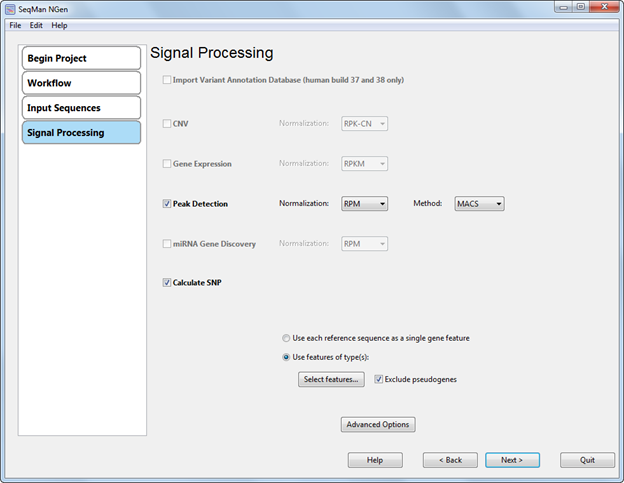
The Assembly and Signal Processing dialog is a specialized version of the Assembly Options dialog, and only appears only if you chose Combined Analysis of Workflows in the Choose Assembly Workflow screen.

•Import Variant Annotation Database (human build 37 and 38 only) –Check this box if you would like to import variant annotations from a specific portion of the NCBI RefSeq database maintained on the DNASTAR website. This checkbox is only available for human samples assembled against builds 37 or 38.
•The CNV, Gene Expression, Peak Detection, miRNA Gene Discovery checkboxes are enabled or disabled depending on the selection(s) in the Workflow drop-down menu in the Add Assembly Projects screen. Check the boxes for the type(s) of signal processing you wish to use, and then make selections from the associated drop-down menu(s). See Peak Detection Methods for detailed information about each of the methods offered in SeqMan NGen, including the workflows with which they can be used.
•Calculate SNP – Check this option if you want to turn on SNP detection. If this box is checked, you can later open the assembly in ArrayStar or SeqMan Pro to view the SNPs.
•Use each reference sequence as a single gene feature – Select this option to use each entire template sequence as a target for mapping reads. When this box is checked, RNA-Seq workflows treat these sequences as isoforms rather than genes. Comparing the mapping coverage to related isoforms provides a way to investigate differential expression of alternately spliced transcripts.
•Use features of type(s) – Select this option to only report results when a specific type of feature is used as the target for mapping reads. (If your template sequences do not contain features, this option will be disabled.) Note that mapping occurs regardless of the type of feature annotation. However, when you choose this option, the mapping results for unwanted feature types will not be reported. Use the Select features button to specify which feature types to use. In the ensuing dialog, the right pane shows features that will be used as targets, and the left pane shows other available feature types.

Select items and then use the Add>> and <<Delete buttons to populate the two sides such that only the desired feature types remain in the right-hand pane. Click OK to return to the Input Reference Sequences screen.
•Exclude pseudogenes –As with the previous option, mapping occurs regardless of the type of feature annotation. However, when you choose this option, mapping results for features with /pseudo in their annotations will not be reported.
•Advanced Assembly Options – Click this button to open the Advanced Assembly Options dialog, which allows you to select additional assembly parameters. See Peak Detection, and Variant for information about options in each tab of the dialog.
Once you are finished, click Next > to continue to the next wizard screen.